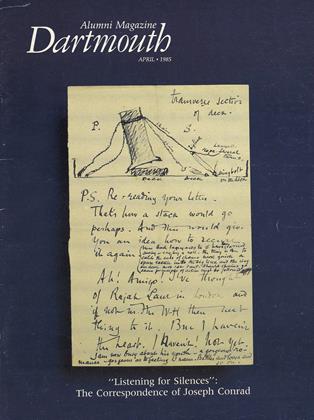With this issue, we re-inaugurate a column that has appeared intermittently and under different headings throughout the history of the Alumni Magazine; "About 25 Years Ago," "Noted Townies of the Past and Present," "Not So Long Ago," and "Notes from the 70s" (1870s, that is), to name but a few. These facts were gathered from The Dartmouth, but submissions of other historical source material for upcoming columns is welcome.
50 Years Ago
In April 1935 a headline of The Dartmouth announced, "Student Anti-War Strike Called Today at 11:15 in Webster Hall"; Dartmouth undergraduates joined more than 100,000 students in the U.S. and abroad in a protest against the war, gathering to listen to speeches. An editorial in The D called war "man-made futility" and urged students toward "preparedness based on knowledge . . . and on conviction."
A fire began in Dartmouth Hall just after 1:00 a.m. on April 25 and did close to $100,000 worth of damage before two fire companies and a large number of student volunteers extinguished the blaze at dawn.
A fire of a different sort was lighted on Mount Rainier in Washington as "Dartmouth's five crack downhill men 'Bern' Woods, Dick Durrance, Warren Olivers, Ted Hunter, and Link Washburn [went] into action on Mount Rainier's precipitous, open slopes . . . [in] the first event in the combined National Championships and Olympic Trials." Three finished in the first five places in slalom and downhill competition: Durrance was second; Hunter, fourth; and Washburn, fifth.
Last, but not least, "word was received by Sidney C. Hay ward, editor of the DartmouthAlumni Magazine, that [it] had been awarded first prize for best class notes section for 1935 by the American Alumni Council; the elected class secretaries were cited for their thorough and complete coverage."
25 Years Ago
The April 1, 1960, issue of The D carried what turned out to be an ideal, though unwitting, April Fools' story but it fired the imaginations of students and administrators alike for a day with promise of untold riches. The headline rang out: "Oil Discovered at Hopkins Center Site." While the geology department hastened to confirm that the black pool that appeared where ground was being broken for the new arts center, at a depth of just 35 feet, was indeed high-grade petroleum, hopes were dashed and a few faces were red as it was discovered that the "black gold" sprang from the pierced shell of the College's 50,000-gallon reserve oil tank. Construction was resumed. T.A.
 View Full Issue
View Full Issue
More From This Issue
-
 Cover Story
Cover StoryListening for the Silences
April 1985 By Laurence Davies -
 Feature
FeatureMinimum Standards
April 1985 By Gayle Gilman '85 -
 Feature
FeatureKey to Success: Dartmouth's Athletic Sponsor Program
April 1985 By Jim Kenyon -
 Feature
FeatureHistorical Notes on the Upper Valley
April 1985 By Jerold Wikoff -
 Feature
FeatureFROM THE DESK OF THE PRESIDENT
April 1985 -
 Article
ArticleWorth his salt
April 1985 By JOseph Berman '86







